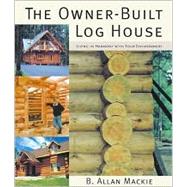
Allan Mackie, the author of many books on log building, is recognized around the world as one of the foremost builders of log houses. The founder of the B. Allan Mackie School of Log Building, he teaches log building not only throughout North America but also in Europe and Asia.
| Introduction | 8 | (5) | |||
|
|||||
| Preamble | 13 | (2) | |||
|
15 | (10) | |||
|
15 | (2) | |||
|
17 | (1) | |||
|
17 | (2) | |||
|
19 | (6) | |||
|
22 | (3) | |||
|
25 | (10) | |||
|
25 | (1) | |||
|
26 | (1) | |||
|
27 | (1) | |||
|
28 | (1) | |||
|
29 | (2) | |||
|
31 | (2) | |||
|
33 | (1) | |||
|
33 | (2) | |||
|
35 | (12) | |||
|
35 | (1) | |||
|
36 | (1) | |||
|
37 | (2) | |||
|
39 | (2) | |||
|
41 | (2) | |||
|
43 | (1) | |||
|
44 | (3) | |||
|
47 | (14) | |||
|
47 | (2) | |||
|
49 | (2) | |||
|
51 | (1) | |||
|
52 | (4) | |||
|
56 | (5) | |||
|
57 | (4) | |||
|
61 | (16) | |||
|
61 | (2) | |||
|
63 | (1) | |||
|
64 | (1) | |||
|
65 | (1) | |||
|
66 | (2) | |||
|
68 | (1) | |||
|
69 | (8) | |||
|
77 | (14) | |||
|
79 | (3) | |||
|
82 | (3) | |||
|
85 | (6) | |||
|
87 | (4) | |||
|
91 | (14) | |||
|
91 | (2) | |||
|
93 | (2) | |||
|
95 | (3) | |||
|
98 | (1) | |||
|
98 | (1) | |||
|
98 | (1) | |||
|
98 | (1) | |||
|
98 | (1) | |||
|
99 | (6) | |||
|
101 | (4) | |||
|
105 | (12) | |||
|
105 | (2) | |||
|
107 | (1) | |||
|
108 | (1) | |||
|
109 | (1) | |||
|
110 | (1) | |||
|
111 | (1) | |||
|
112 | (1) | |||
|
113 | (1) | |||
|
114 | (3) | |||
|
117 | (15) | |||
|
117 | (2) | |||
|
119 | (1) | |||
|
120 | (1) | |||
|
120 | (1) | |||
|
121 | (2) | |||
|
123 | (2) | |||
|
125 | (1) | |||
|
126 | (1) | |||
|
127 | (1) | |||
|
128 | (4) | |||
|
129 | (3) | |||
|
132 | (7) | |||
|
132 | (1) | |||
|
133 | (1) | |||
|
134 | (2) | |||
|
136 | (1) | |||
|
137 | (2) | |||
|
139 | (10) | |||
|
139 | (1) | |||
|
140 | (1) | |||
|
141 | (1) | |||
|
141 | (1) | |||
|
142 | (3) | |||
|
145 | (1) | |||
|
146 | (3) | |||
|
149 | (18) | |||
|
151 | (3) | |||
|
154 | (5) | |||
|
159 | (2) | |||
|
161 | (1) | |||
|
161 | (6) | |||
|
163 | (4) | |||
|
167 | (12) | |||
|
167 | (3) | |||
|
170 | (1) | |||
|
170 | (1) | |||
|
171 | (1) | |||
|
172 | (1) | |||
|
173 | (1) | |||
|
173 | (1) | |||
|
174 | (2) | |||
|
176 | (3) | |||
|
179 | (18) | |||
|
179 | (1) | |||
|
180 | (2) | |||
|
182 | (1) | |||
|
183 | (2) | |||
|
185 | (1) | |||
|
186 | (1) | |||
|
187 | (2) | |||
|
189 | (3) | |||
|
192 | (5) | |||
|
194 | (3) | |||
|
197 | (14) | |||
|
197 | (1) | |||
|
198 | (3) | |||
|
201 | (3) | |||
|
204 | (1) | |||
|
205 | (1) | |||
|
206 | (1) | |||
|
207 | (4) | |||
|
208 | (3) | |||
|
211 | (10) | |||
|
211 | (2) | |||
|
213 | (1) | |||
|
214 | (2) | |||
|
216 | (1) | |||
|
216 | (1) | |||
|
216 | (5) | |||
|
218 | (3) | |||
| Glossary | 221 | (2) | |||
| Appendix | 223 | (3) | |||
| Index | 226 |
The New copy of this book will include any supplemental materials advertised. Please check the title of the book to determine if it should include any access cards, study guides, lab manuals, CDs, etc.
The Used, Rental and eBook copies of this book are not guaranteed to include any supplemental materials. Typically, only the book itself is included. This is true even if the title states it includes any access cards, study guides, lab manuals, CDs, etc.